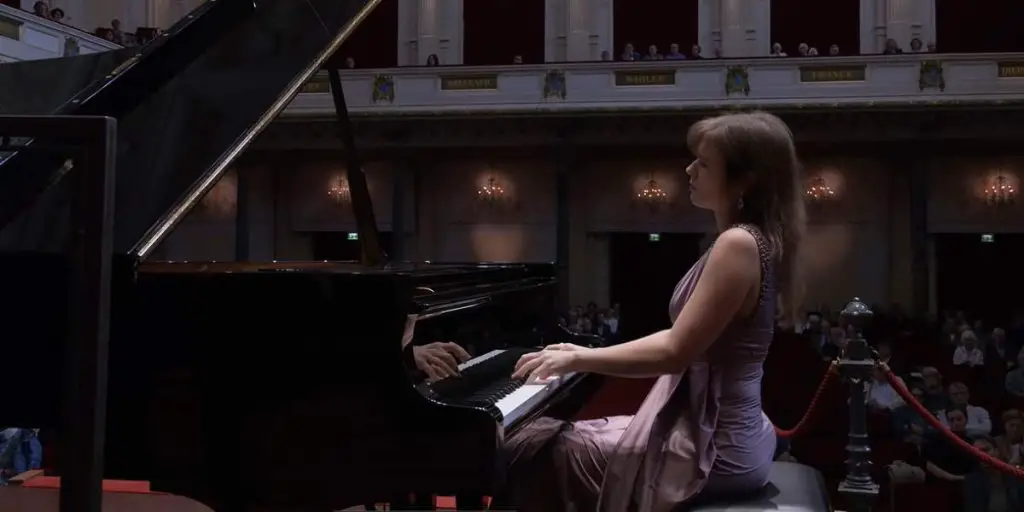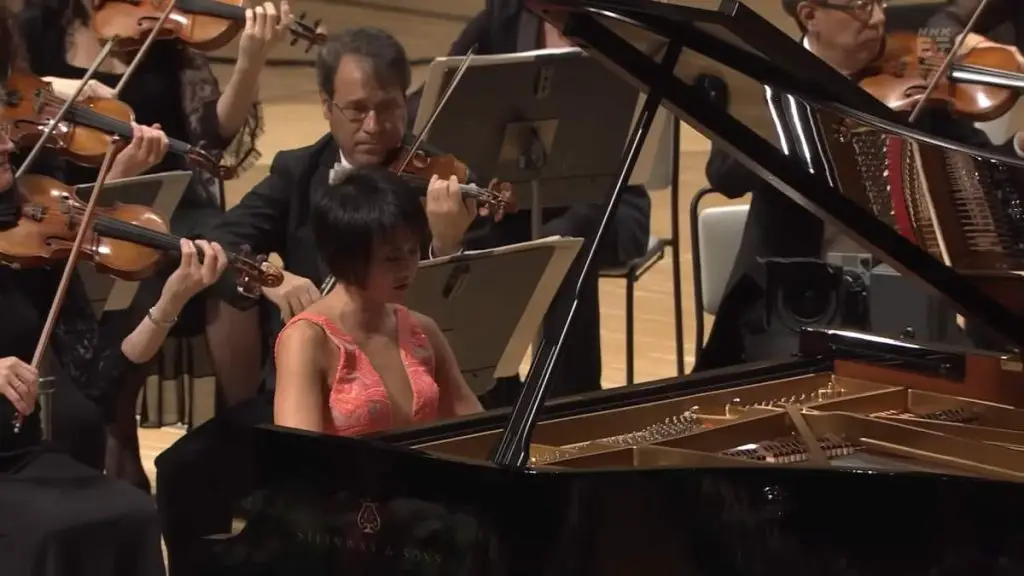Accompanied by the Nederlands Kamerorkest (Netherlands Chamber Orchestra), French classical pianist Alexandre Kantorow performs Frédéric Chopin’s Piano Concerto No. 2 in F minor, Op. 21. Concertmaster and musical director: Gordan Nikolić. Recorded on October 12, 2020, at the Concertgebouw Amsterdam.
Frédéric Chopin’s Piano Concerto No. 2
The Piano Concerto No. 2 in F minor, Op. 21 is one of the most famous compositions by Polish composer Frédéric Chopin. It was composed in 1829-1830, when Chopin was only 19 years old, and premiered on March 17, 1830, in Warsaw with Chopin himself as the soloist.
It was the second of Chopin’s piano concertos to be published (after Piano Concerto No. 1), and so was designated as “No. 2”, even though it was written first.
The concerto is known for its beautiful melodies, virtuosic piano writing, and masterful orchestration. It showcases Chopin’s unique style, which combines the lyricism and expressiveness of the Romantic era with the technical brilliance of the virtuoso pianist.
The Piano Concerto No. 2 is one of Chopin’s most popular and frequently performed works and has been recorded by many renowned pianists and orchestras. It is a true masterpiece of the Romantic piano concerto repertoire.
Movements
The concerto consists of three movements, with start times in the video:
- 00:00 Maestoso
- 15:19 Larghetto
- 25:33 Allegro vivace
1. Maestoso
The first movement of Chopin’s Piano Concerto No. 2 in F minor, Op. 21 is marked Maestoso, which means “majestic” or “stately”. It is a large-scale sonata form, which is a traditional structure used in classical music.
The movement opens with a dramatic orchestral introduction, featuring a powerful fanfare and a stormy passage in the strings. The piano then enters with a virtuosic cadenza-like passage, which leads into the main theme. The main theme is a majestic and heroic melody played by the piano, accompanied by the orchestra.
The movement features a number of contrasting themes, including a lyrical second theme introduced by the woodwinds and a more subdued third theme played by the piano. These themes are developed and expanded upon throughout the movement, showcasing Chopin’s mastery of form and structure.
The development section is particularly virtuosic, with the piano and orchestra engaging in a fiery dialogue of rapid scales, arpeggios, and trills. The recapitulation brings back the main theme but with some subtle changes and variations.
The movement ends with a brilliant coda, featuring a final flourish of virtuosic piano playing and a triumphant statement of the main theme by the orchestra.
2. Larghetto
The second movement of Chopin’s Piano Concerto No. 2 in F minor, Op. 21 is marked Larghetto, which means “fairly slow” in tempo. It is a lyrical and expressive piece, which stands in contrast to the drama and energy of the first movement.
The movement opens with woodwinds. Then, the piano enters with a gentle and beautiful melody, accompanied by the strings. The piano and orchestra engage in a dialogue, with the piano playing ornate variations on the theme while the strings provide a delicate accompaniment.
The main theme of the movement is one of Chopin’s most famous and beautiful melodies, featuring a poignant and melancholic melody played by the piano, accompanied by a delicate string choir. The theme is repeated and developed throughout the movement, with the piano adding ornate embellishments and variations.
The middle section of the movement features a more agitated and intense section, with the piano and orchestra engaging in a dialogue of increasing tension and drama. However, the movement returns to its lyrical and gentle character, with a reprise of the main theme played by the piano and orchestra.
The movement ends with a soft and delicate coda, featuring a final statement of the main theme played by the piano and strings, before fading away into silence.
3. Allegro vivace
The finale of Chopin’s Piano Concerto No. 2 is marked Allegro vivace, which means “fast and lively” in tempo. It is a highly virtuosic and energetic movement, featuring a lively dialogue between the piano and orchestra.
The movement opens with a rapid and playful theme played by the piano, which is then taken up by the orchestra. The piano and orchestra engage in a virtuosic and frenzied dialogue, with the piano playing rapid arpeggios and running while the orchestra provides a lively accompaniment.
The middle section of the movement features a more lyrical and expressive theme, introduced by the strings and then taken up by the piano. This section provides a brief respite from the frenetic energy of the opening, before returning to the lively and energetic dialogue between the piano and orchestra.
The movement builds to a brilliant and virtuosic climax, with the piano and orchestra engaging in a final flurry of rapid scales, arpeggios, and trills. The movement ends with a triumphant statement of the main theme by the orchestra, followed by a final flourish of virtuosic piano playing.
Alexandre Kantorow
Alexandre Kantorow (born 20 May 1997) is a French pianist. Described by Gramophone as a “fire-breathing virtuoso with a poetic charm” and by Fanfare as “Liszt reincarnated”, he won the first prize, gold medal, and Grand Prix at the 16th International Tchaikovsky Competition in 2019. With this win, Kantorow became the first French winner in the history of the competition.
Kantorow was born in Clermont-Ferrand to a family of musicians; his father is the violinist and conductor Jean-Jacques Kantorow and his mother is also a violinist. He began to study piano at the age of five at the Conservatory of Pontoise.
At the age of 11, Kantorow began studies with Pierre-Alain Volondat, who was the winner of the 1983 Queen Elisabeth Competition in Belgium, and continued training with Igor Lazko at the Schola Cantorum de Paris, as well as with Frank Braley and Haruko Ueda.
![Chopin: Piano Concerto No. 2 [Alexandre Kantorow]](https://cdn-0.andantemoderato.com/wp-content/uploads/2023/04/Chopin-Piano-Concerto-No-2-Kantorow-Nikolic-1024x576.jpg)
When he was 16 years old, Kantorow was invited to play at the La Folle Journée festival in Nantes and has since appeared at such festivals as the Festival de La Roque-d’Anthéron, the Festival Chopin à Paris, and the Festival Piano aux Jacobins.
At the age of 17, he performed at the Philharmonie de Paris with the Pasdeloup Orchestra in its inaugural season to an audience of about 2,500.
He has since appeared at major concert halls including the Konzerthaus Berlin, Concertgebouw in Amsterdam, the BOZAR in Brussels, and the auditorium in the Louis Vuitton Foundation. Kantorow currently studies with Rena Shereshevskaya, who was also the teacher of Lucas Debargue, at the École Normale de Musique de Paris.
In 2019, Kantorow won the first prize, gold medal, and Grand Prix at the 16th International Tchaikovsky Competition, becoming the first French winner in the history of the competition. He was the only finalist in the competition to play the Tchaikovsky Piano Concerto No. 2 in G major and also performed Brahms’ Piano Concerto No. 2 in B-flat major.
Sources
- Piano Concerto No. 2 (Chopin) on Wikipedia
- Alexandre Kantorow on Wikipedia
- Alexandre Kantorow’s official website



